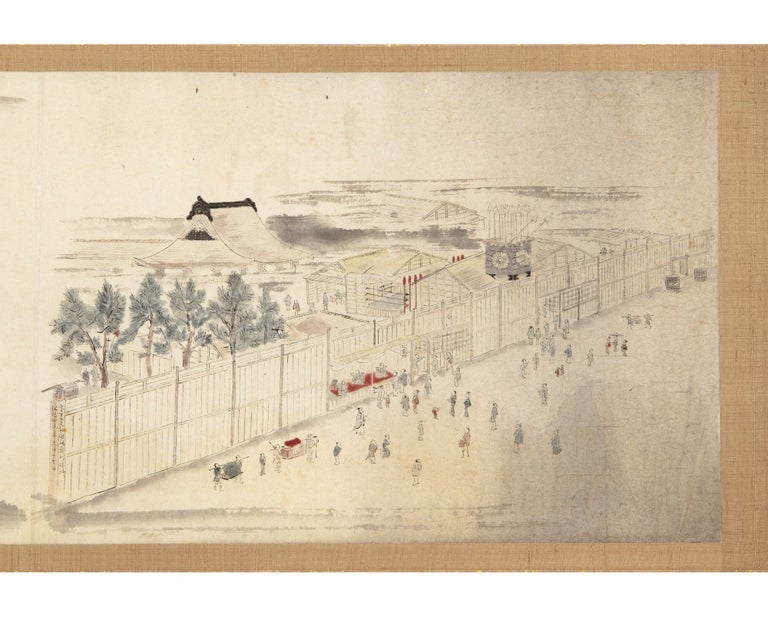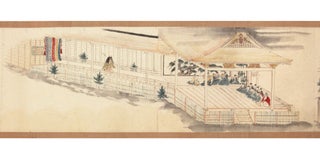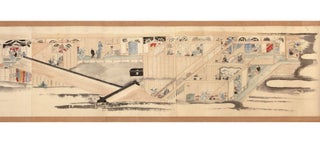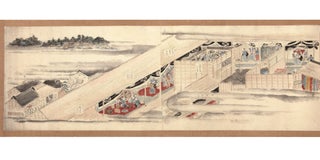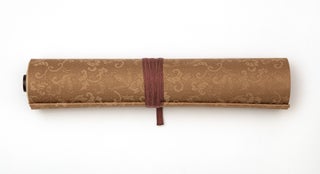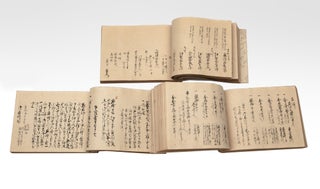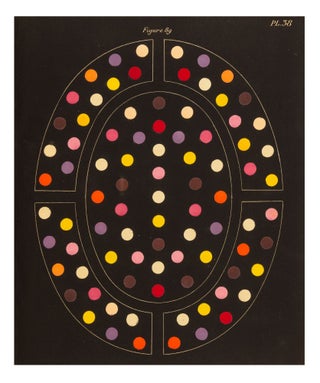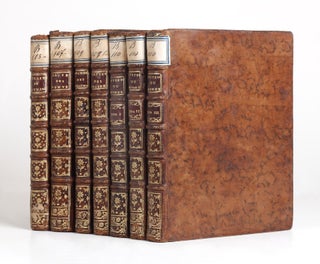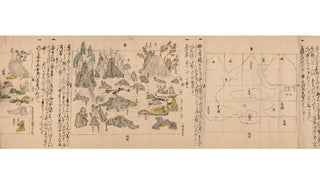The Kanjin Noh Performances of 1848
Illustrated scroll on fine paper concerned with the final Noh subscription performances, of 1848, by the Hosho ryu (school) of Noh.
Scroll (310 x 4130 mm.), with silk borders & silk brocade on outside of front endpaper, wooden roller, recently & expertly backed. [Edo: late Edo].
An important document for Noh theater. Our scroll depicts the buildings, stage, and back rooms of the theater constructed for the Kanjin Noh performances of 1848. They took place at Sujikaibashi in Edo and were organized by the Hosho ryu (school) of Noh, whose chief performer was Hosho Tayu XV. This school was founded in the 14th century and was known for its emphasis on its dignity and the sensitivity and refinement of its singing. The Hosho ryu school thrives today with regular performances in the main Noh theater in Bunkyo, near the Tokyo Dome.
Kanjin Noh (“benefit Noh”) were originally subscription Noh performances held to raise money for worthy causes, such as construction or repair of temples and shrines. The tradition began in the 14th century. However, by the Edo period, the Kanjin Noh performances had turned into commercial ventures, bringing profits chiefly to the producers and performers. In the Edo period, there were eight such events: 1607, 1624, 1656, 1687, 1750, 1816, 1831, and 1848.
These commercial Kanjin Noh were elaborate productions that took place at open areas within major urban centers. The performances were authorized by the bakufu as a form of support for the official Noh troupes; the head of each company was allowed one major public event in a lifetime. Through the Edo period, Kanjin Noh grew in complexity and length (one lasted 15 days). A vast performance area of three to four acres, large enough for several thousand daily spectators, was constructed, with boxes and spaces reserved for special guests. A drum tower (yagura, erected to literally drum up business) was built to attract the public. The entire large area was enclosed by a tall wooden board fence. Announcements advertising the event were posted in the busiest parts of Edo, and drummers were sent throughout the city to notify the population. The major Kanjin Noh productions were financed by mandatory contributions from the samurai and local citizenry.
This handsome scroll contains four detailed scenes of the buildings, stage, and back rooms of the theater built for the 1848 Kanjin Noh performances held at Sujikaibashi. The scenes are painted with brush & washes of various colors.
1. The first image has an elevated perspective, drawn from the Sujikaibashi (Sujikai bridge), and shows the walled front of the performance area, with the yagura (with the Hosho ryu crest) and three entrances for the different classes of audience. Attendees are shown milling around the front of the entrances. From this perspective, we can see inside the various buildings. One pillar of the wall has a written legend (in trans.): “The place for Hosho Tayu [XV] Kanjin Noh performance / 17 November 1847.” Although the performances took place in February and March of 1848, the construction of the stage and related buildings took many months of advance work.
2. The following scene, which is quite long, depicts the traditional roofed small stage with the musicians and singers seated around it. Also shown is the long hashigakari (bridgeway) for entrances and exits and additional scenes. On the bridge, we see a fully dressed actor approaching the stage to perform in Ataka, which was written in 1465.
3. This fine scene shows the bridgeway and the kagami-no-ma (the “mirror room,” where the actors prepare themselves before going on stage). Nine fully costumed actors are shown on the bridgeway approaching the stage, led by Yoshitsune and Benkei, two important characters in Ataka.
4. The fourth and final scene is very long and depicts in a complex panoramic view — a good example of fukinuki yatai (literally, “roof blown off,”enabling us to see into the rooms) — the many backstage buildings and rooms for the actors, props, and theater workers as well as private rooms for dignitaries. This very useful image reveals how all the rooms and the actual performing stage are connected. Dozens of people are shown in their various occupations. We see a kitchen, dressing rooms (three are elaborately decorated private dressing rooms for the main characters), communal rooms for others including the musicians and singers, the mirror room and bridgeway, the roof of the stage, storage areas for the props and musical instruments, the private rooms for distinguished guests, etc. As is common in these types of illustrated scrolls, there are long painted ribbons of mist. In the background, across the river, we see more of Edo in the distance.
In fine condition. There is some very minor worming.
❧ Almost all of this description is based on Gerald Groemer’s wonderful and detailed “Elite Culture for Common Audiences: Machiiri No and Kanjin No in the City of Edo” in Asian Theatre Journal, Vol. 15, No. 2 (Autumn 1998), pp. 230-52.
Price: $7,500.00
Item ID: 8116

